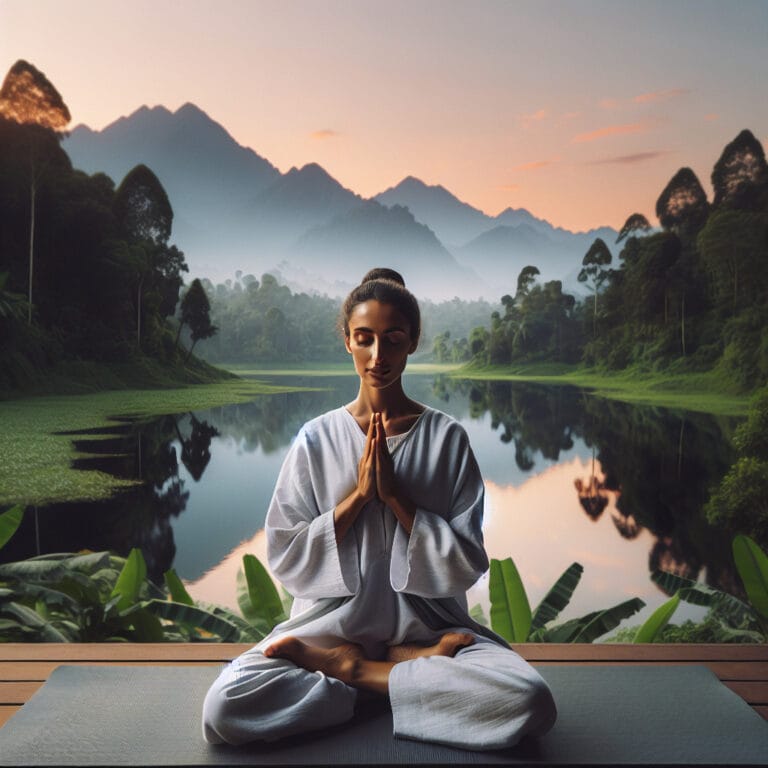
Master Advanced Pranayama Techniques for an Instant Energy Boost
Table of Contents
- Introduction to Pranayama
- Understanding Pranayama: Definition, History, and Science
- Mastering Basic Pranayama Techniques
- Exploring Advanced Pranayama Techniques
- Pranayama for Energy Boost: Techniques and Tips
- Conclusion: The Power and Benefits of Pranayama
- Frequently Asked Questions
Introduction to Pranayama
While it might appear counterintuitive, the ancient breath technique of Pranayama, traditionally practiced in yogic practices such as Hatha and Kundalini Yoga, can significantly boost energy levels. With roots embedded deep in the wisdom of yoga practices, Pranayama is a powerful tool to increase and cultivate ‘prana,’ or life force. In our fast-paced everyday life, we often let stress take over our body and mind. However, by following regular practice of unique yogic breathing techniques such as Bhastrika Pranayama or alternate nostril breathing – tools that engage both autonomic nervous system functions – one can elevate cognitive functions to their highest capacity along the path to achieving peace and love.
Begin your morning routine with simple yoga lessons focused on enhancing prana flowing through your body’s network via your breath; an understanding you will gain from practicing yoga regularly. By incorporating these yogic principles into a daily morning breathing practice routine before sun salutations or other posture flows, you can witness major ways this ancient path brings tangible health benefits.
To experience these benefits fully necessitates mastering specific energy breathing techniques; so here’s a step-by-step guide for beginners: Start by sitting comfortably with a straight spine; close your eyes while keeping your mouth closed to keep distractions at bay. Initiate belly breathing by inhaling deeply through the nose till your lower belly expands – this helps stimulate parasympathetic activity via the vagus nerve that calms down the sympathetic nervous system responsible for ‘fight or flight’ responses.
Take each deep breath consciously until you feel entirely present in each moment—a concept central to every effective breathwork technique—whether it’s alternate nostril breathing or Bhastrika pranayama (the hissing breath). These techniques are not just about inhaling oxygen but more about regulating carbon dioxide levels which plays a significant role in calming anxiety and increasing alignment between mind-body dimensions.
Don’t rush; remember, each breath retention should be comfortable. Gradually increase the duration as you get more familiar with these techniques. You can also follow a guided video to better understand and execute your breathing exercise.
These Pranayama practices are much more than mere techniques; they are a way of life that combines yogic teaching and practice generosity towards your body and mind, helping you reach the highest goal of yoga – liberation or moksha. They not only enhance physical wellbeing but also contribute to mental clarity, emotional stability, and spiritual growth.
So why wait? Rejuvenate your nervous system today by integrating this potent yoga pranayama into your routine – an investment sure to pay rich dividends in boosting energy levels while ensuring enhanced overall health. Try it for yourself to realize how this disciplined approach goes beyond being just a morning breathing exercise – it’s the gateway to holistic well-being!
Understanding Pranayama: Definition, History, and Science
Harnessing the energy of life force or ‘prana’ through Pranayama practice is an integral part of yogic practices, enhancing health benefits by rejuvenating the nervous system and boosting mental clarity. Bhastrika Pranayama, known as the hissing breath, is one such potent breathing technique traditionally practiced in Hatha and Kundalini yoga. This ancient breath technique involves rapid inhalation and exhalation that stimulates both parasympathetic activity via the vagus nerve as well as sympathetic nervous system functions – a balanced interplay that yields increased focus and calmness alike.
A morning routine incorporating these techniques can transform your day. Start with belly breathing; sit comfortably with a straight spine, eyes closed, mouth closed while ensuring your lower belly expands on each deep breath inhaled from the left nostril. It’s not just about inhaling oxygen but also about regulating carbon dioxide levels that play a crucial role in calming anxiety and creating alignment between mind-body dimensions.
For beginners taking their first steps into pranayama practice or seasoned practitioners looking to refine their skills further, guided videos can be incredibly beneficial for learning correct posture flows during these energy breathing techniques. The key is to always remain present with each breath retention; this consciousness anchors you firmly within each moment – a cornerstone principle in every effective yogic practice.
Adopting regular Pranayama routines like alternate nostril breathing has been proven to improve cognitive functions significantly over time. The rhythmical pattern of inhaling through one nostril at a time helps revitalize both hemispheres of our brains equally – enhancing overall neural functioning as we navigate our everyday life.
Delving deeper than mere physical wellbeing, these morning breathing exercises chart out an ancient path towards spiritual elevation too – aligning perfectly with yogic principles that accentuate balance between body-mind-spirit trinities all geared towards attaining Moksha (liberation) – the highest goal in yogic teachings.
Whether it’s a simple sun salutation or complex Hatha yoga, integrating Pranayama techniques into your daily routine can be transformative. It ensures a steady prana flowing within and brings about an unparalleled sense of peace and love, reinforcing that morning breathing practice is much more than just an energy boost; it’s a gateway to holistic well-being. So why wait? Embark on this journey of self-discovery with yoga pranayama today!
Mastering Basic Pranayama Techniques
Fueling the body with life force or ‘prana’, Pranayama techniques form an integral part of yogic practices, known for their immense health benefits. Delving into these practices, we find that these energy breathing techniques range from simple exercises to more advanced forms, each boasting unique benefits. A perfect example is Anulom Vilom or alternate nostril breathing. This ancient breath technique involves rhythmic inhalation and exhalation through the left nostril then switching to the right – a practice that stimulates both parasympathetic activity via the vagus nerve and sympathetic nervous system functions. The result? A calm mind coupled with heightened cognitive functions.
For beginners embarking on this path of yoga pranayama, maintaining correct posture is key; keeping a straight spine while sitting comfortably during practice helps optimize breath flow essential for harnessing ‘prana’. Equally important is keeping your eyes closed, which aids in internalizing focus and enhancing the overall efficacy of morning routine.
Another potent Pranayama technique is Kapalbhati – often termed as rapid belly breathing. Through intense bouts of rapid exhalations followed by passive inhalations, it promotes detoxification by expelling carbon dioxide buildup in blood whilst invigorating one’s nervous system – acting like nature’s own energy booster to kick-start your day!
Yet another stimulating addition to your morning routine can be Bhastrika Pranayama (also known as bellows breath). Resembling hissing breaths commonly found in Kundalini Yoga traditions, this technique involves quick cycles of forceful breaths – boosting metabolic rate while empowering autonomic nervous system responses akin to sympathetic arousal.
Learning these yoga lessons does not necessitate rushing through your pranayama practice; instead embracing patience allows you achieve optimal results over time. Gradual adaptation with regular practice encourages a natural increase and cultivation of life force within our bodies.
To simplify the learning curve, beginners can turn to a guided video. Providing clear instructions on correct posture flows and breathing technique nuances, it offers a safe and effective way to master these practices at your own pace.
Finally, remember that Pranayama is not just about mastering breathwork techniques; rather it’s an inward journey providing major ways for personal growth – aligning mind-body dimensions while practicing generosity towards our own self. The morning breathing exercises traditionally practiced in Hatha yoga are more than mere health rituals; they chart an ancient path to peace and love through unlocking highest capacities of human potential – truly embodying the highest goal of yogic teaching. Hence, regular practice of these energy boosting pranayama techniques can be your gateway to holistic well-being.
| Pranayama Techniques | Description | Benefits |
|---|---|---|
| Anulom Vilom | Rhythmic inhalation and exhalation through alternate nostrils. | Stimulates parasympathetic activity via the vagus nerve and sympathetic nervous system functions. Calms the mind and enhances cognitive functions. |
| Kapalbhati | Rapid bouts of exhalations followed by passive inhalations. | Promotes detoxification by expelling carbon dioxide buildup in blood. Invigorates the nervous system. Acts as natural energy booster. |
| Bhastrika Pranayama | Quick cycles of forceful breaths. | Boosts metabolic rate. Empowers autonomic nervous system responses akin to sympathetic arousal. |
| General Tips for Beginners | Maintain correct posture. Keep eyes closed. Embrace patience. Regular practice. Use of guided videos. | Optimizes breath flow. Enhances internal focus. Achieves optimal results over time. Allows safe and effective learning at own pace. |
| Pranayama Overall Benefits | Aligns mind-body dimensions. Encourages generosity towards self. Aids in personal growth. | Unlocks highest capacities of human potential. Provides a path to peace and love. Can be a gateway to holistic well-being. |
Exploring Advanced Pranayama Techniques
The transformative power of Pranayama practices extends beyond the foundational techniques, reaching into advanced methods like Surya Bhedana, Chandra Bhedana, and Bhramari. These energy-boosting breathing techniques take your morning routine to a new level of vitality and mindfulness, infusing every breath with an amplified life force.
Surya Bhedana or the Sun Piercing Breath is one such technique that primarily involves inhaling through the right nostril – considered the sun channel in yogic teachings. This practice promotes sympathetic nervous system activation; it’s like inviting the warmth and radiance of sunlight into our body-mind matrix every morning. Such mindful practices can notably enhance cognitive functions over time by activating neural circuits that boost focus and mental agility – a health benefit that positively affects everyday life.
Next up is Chandra Bhedana or Moon Piercing Breath, which is traditionally practiced by inhaling through the left nostril – seen as a lunar channel in yoga philosophy. The essence of this ancient breath technique lies in stimulating parasympathetic activity via the vagus nerve. Here’s how you can incorporate this method into your practice: sit comfortably with a straight spine while taking deep belly breaths through your left nostril – allowing all distractions fade as you close your eyes for enhanced focus during this calming exercise.
Last but not least, meet Bhramari pranayama, also known as Bee Breathing Technique due to its characteristic humming sound created during exhalation. Known for its stress-relieving effects on our autonomic nervous system function, regular practice has been shown to lower heart rate while promoting relaxation – making it an excellent addition to any yogi’s toolbox seeking major ways to cultivate peace and love amidst their hectic schedules.
Undeniably powerful yet subtle in their impact on physical health and cognitive functions alike; these advanced Pranayama techniques are treasures waiting to be discovered by those willing to journey deeper into yogic practice. Whether you are just starting out with pranayama or seeking more advanced techniques, remember that it’s not only about mastering the posture flows and breath retention but also immersing yourself fully in the experience – a philosophy best captured in this yogic principle: “It’s not just about moving through life, it’s about letting life move through you.”
So whether it’s before your sun salutations or as part of your wind-down routine before bed, challenge yourself to incorporate these energy breathing techniques into your daily yoga practice. Experience for yourself how they can boost vibrancy while aiding relaxation; after all, regular Pranayama is more than just an exercise – it’s an exploration of the ancient pathways to holistic well-being!
| Pranayama Technique | Description | Benefits | Method |
|---|---|---|---|
| Surya Bhedana (Sun Piercing Breath) | A technique that involves inhaling through the right nostril, considered the sun channel in yogic teachings. | Promotes sympathetic nervous system activation, enhances cognitive functions, boosts focus and mental agility. | Inhale through the right nostril, inviting the warmth and radiance of sunlight into the body-mind matrix. |
| Chandra Bhedana (Moon Piercing Breath) | A technique that is traditionally practiced by inhaling through the left nostril, seen as a lunar channel in yoga philosophy. | Stimulates parasympathetic activity via the vagus nerve, enhances focus, promotes calmness. | Sit comfortably with a straight spine while taking deep belly breaths through the left nostril. Close your eyes for enhanced focus during this calming exercise. |
| Bhramari Pranayama (Bee Breathing Technique) | A technique known for its characteristic humming sound created during exhalation. | Relieves stress, lowers heart rate, promotes relaxation. | Produce a humming sound during exhalation, promoting relaxation and peace. |
Pranayama for Energy Boost: Techniques and Tips
Ancient yogic practices provide a treasure trove of energy breathing techniques, designed not only to boost physical vitality but also to enhance cognitive functions and promote emotional balance. At the heart of these practices is Pranayama, a refined art that harnesses the power of breath – our life force – to rejuvenate our entire body-mind system. Techniques such as alternate nostril breathing or Bhastrika pranayama have been traditionally practiced in Hatha and Kundalini yoga to stimulate both parasympathetic activity via the vagus nerve and sympathetic nervous system functions. The balanced interplay of these autonomic nervous systems results in an unmatched surge of energy.
Incorporating Pranayama into your morning routine can be transformative; it sets a positive tone for the day by increasing ‘prana’ flowing within you right from the start. It’s more than just deep belly breathing with your mouth closed and eyes closed; it’s about being conscious with each breath you take while maintaining a straight spine for optimal flow of life force. Undertaking this ancient breath technique daily helps regulate carbon dioxide levels in blood, thereby reducing anxiety and promoting mind-body alignment.
For beginners starting their journey into Pranayama practice or even seasoned practitioners seeking further refinement, guided videos offer valuable insights into perfecting posture flows for different techniques. Whether it’s sun salutations or complex Hatha yoga poses, integrating Pranayama brings major health benefits while boosting energy levels significantly – truly making them an essential part of any yogic practice!
Conclusion: The Power and Benefits of Pranayama
The transformative power of Pranayama techniques in boosting energy cannot be overstated. By integrating specific breathing exercises into your morning routine, you can unlock the full potential of your mind and body. Ancient breath techniques like alternate nostril breathing or Bhastrika Pranayama serve as a natural conduit for ‘prana’ – our essential life force – to permeate every cell of our being, thereby rejuvenating the entire nervous system. Far from being just another exercise regimen, these yogic practices align with the highest goal of yoga – achieving unity between mind and body while fostering peace and love within us. Following a guided video can streamline this learning curve and help assimilate these posture flows seamlessly into your daily yoga practice. The health benefits are manifold; regular pranayama practice has been traditionally linked to enhanced cognitive functions, mental clarity, emotional balance – all while turbocharging your energy levels naturally! So embark on this journey towards harnessing your highest capacity through consistent pranayama practice – after all, it’s not just about moving through life but letting life move through you!



